Table of Contents
Dealing with breakouts can be a real pain, and sometimes those harsh treatments just don’t feel right. You might have heard that natural remedies can help, and tea is often mentioned. So, does tea bags help with acne? Turns out, many types of tea have compounds that could make a difference for your skin. We’re going to look at how different teas might help calm inflammation, fight off bacteria, and maybe even balance things out, all from your favorite warm drink.
Key Takeaways
- Green tea is a top contender for acne relief due to its anti-inflammatory and antioxidant properties, with some studies showing it’s as effective as common acne treatments.
- Applying cooled tea bags or brewed tea directly to the skin can help reduce redness and swelling associated with acne.
- Other teas like chamomile, spearmint, and rooibos also offer benefits such as reducing inflammation, balancing hormones, and fighting bacteria.
- For a more targeted approach, you can combine green tea with ingredients like tea tree oil or use tea extracts in skincare products.
- Always use high-quality teas and be aware of potential side effects; consistency is important for seeing results, and consulting a health professional is a good idea.
Understanding Tea’s Role in Acne Management
When you’re trying to figure out how to treat acne with tea, it’s good to know why it might actually work. Tea, especially certain kinds, has compounds that can help calm down the skin and fight off the stuff that causes breakouts. It’s not magic, but there’s some science behind it.
Does Green Tea Help With Acne?
Yep, it seems like it does. Green tea is often talked about when people discuss tea for skin inflammation. It’s packed with antioxidants, which are like little helpers that protect your skin cells. One of the main antioxidants in green tea is called EGCG, and studies suggest it can help reduce inflammation and also lower the amount of oil your skin produces. Too much oil is a big reason why pores get clogged and lead to pimples, so anything that helps manage that is a win.
The Science Behind Tea and Skin Health
So, how exactly does tea help clear acne? It mostly comes down to a few key things. First, many teas have anti-inflammatory properties. This means they can help reduce the redness and swelling that comes with a breakout. Second, some teas have antioxidants that fight off damage from things like pollution and stress, which can make acne worse. Lastly, certain compounds in tea can even help fight the bacteria that contribute to acne.
Key Compounds in Tea for Acne Relief
What makes tea so good for your skin? It’s all about the natural chemicals inside. Here are some of the big players:
- Antioxidants: These fight off damage and can help calm inflammation. Think of them as your skin’s protectors.
- Anti-inflammatory agents: These directly tackle redness and swelling.
- Antimicrobial properties: Some teas can help combat the bacteria that cause acne.
It’s pretty interesting how these natural ingredients can have such a direct impact on skin health. Understanding these components gives you a better idea of how to treat acne with tea effectively.
👉 Discover the Best Tea for Acne and Boost Confidence Now 👈
Preparing Tea for Topical Application
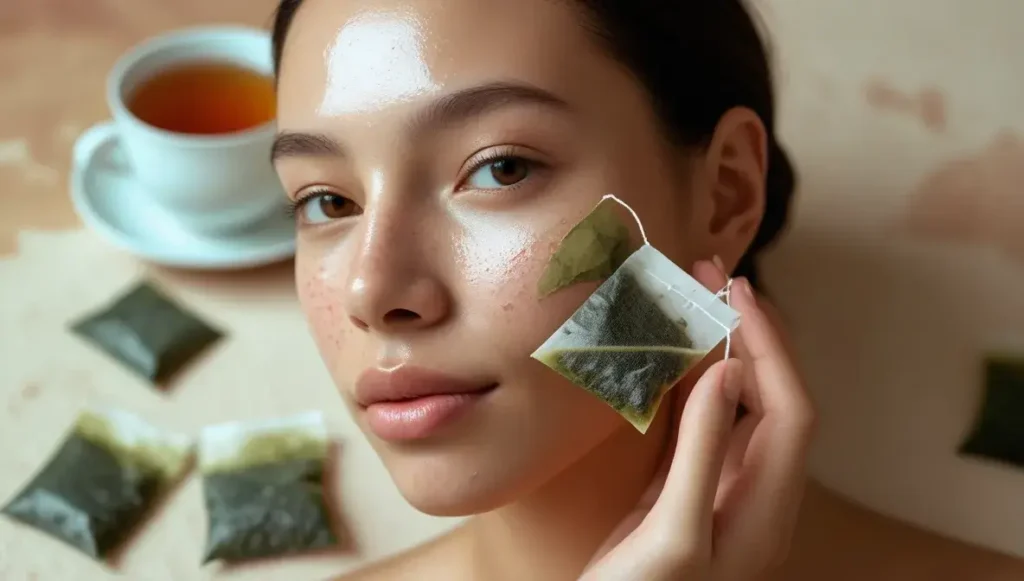
Getting your tea ready for skin application is pretty straightforward, but there are a few things to keep in mind so you don’t end up with a mess or, worse, a burn. It’s not complicated, but doing it right makes a difference.
Brewing Your Chosen Tea
First things first, you need to brew your tea. Whether you’re using tea bags or loose leaves, the process is similar. Pour freshly boiled water over your tea and let it steep for about five minutes. This gives the water enough time to pull out all those good compounds from the tea leaves. Don’t over-steep, though, as that can sometimes make the brew bitter, which isn’t ideal for your skin.
Cooling Tea for Safe Skin Use
This is a super important step. You absolutely cannot apply hot tea or a hot tea bag to your face. It’s just asking for trouble and could lead to burns. So, after brewing, you need to let the tea cool down completely. You can leave the tea bag in the water as it cools, or remove it. Just be patient and wait until it’s at room temperature or even slightly cool. Your skin will thank you for it.
Utilizing Tea Leaves and Brewed Tea
Once your tea is brewed and cooled, you have a couple of options. You can use the cooled tea bags directly, which is super convenient. Or, if you used loose leaves, you can strain them out. Some people like to gently press the leaves to get any extra liquid out and then use the damp leaves themselves. The brewed tea liquid can be used as a toner, or you can soak a clean cloth in it to make a sort of compress. Basically, both the liquid and the leaves can be put to good use for your skin.
Effective Methods for Applying Tea Topically

So, you’ve brewed up some tea and let it cool – awesome! Now, how do you actually get those good stuff from the tea onto your skin? There are a few ways to go about it, and they’re pretty simple.
Using Cooled Tea as a Toner
This is probably the easiest method. After you’ve washed your face, just grab a cotton ball or pad, dip it into your cooled tea, and gently swipe it over your skin. It’s like a little refresh. Let it dry on your face for about 10 minutes, then you can rinse it off with cool water. It’s a nice way to get some of the benefits of tea bags on skin without much fuss.
Creating a Soothing Tea Poultice
If you’ve got a specific spot that’s really red or angry, a tea poultice can be really soothing. You just soak a small, clean cloth or even a piece of gauze in the cooled tea. Wring out the excess liquid so it’s not dripping everywhere, and then lay it gently over the irritated area. Leave it on for about 15 minutes. This is a great way to use a tea bag compress for redness. It feels really nice, kind of like a mini spa treatment at home.
Applying Cooled Tea Bags Directly
This is super straightforward. Once your tea bags have cooled down enough so they won’t burn you, you can just place them directly onto your face. Some people like to put them on specific blemishes, while others might place them under their eyes for puffiness. Just relax with them on for about 10-15 minutes. It’s a really direct way of using tea bags on skin, and you can feel the coolness working.
Remember to always use cooled tea. Hot tea can irritate your skin, and we’re trying to calm things down, not make them worse! Also, after you’re done with any of these methods, it’s a good idea to put on a light moisturizer. That helps keep your skin from getting too dry.
Here’s a quick rundown of how to apply tea bags to face:
- Toner: Cotton ball/pad soaked in cooled tea, swipe on, let dry, rinse.
- Poultice: Cloth soaked in cooled tea, place on affected area, leave for 15 mins.
- Direct Application: Cooled tea bags placed directly on skin for 10-15 mins.
It’s all about finding what feels best for your skin and what fits into your routine. Experiment a little and see what works for you!
👉 Try Our Top Premium Acne Tea to Transform Your Skin 👈
Specific Teas Beneficial for Acne
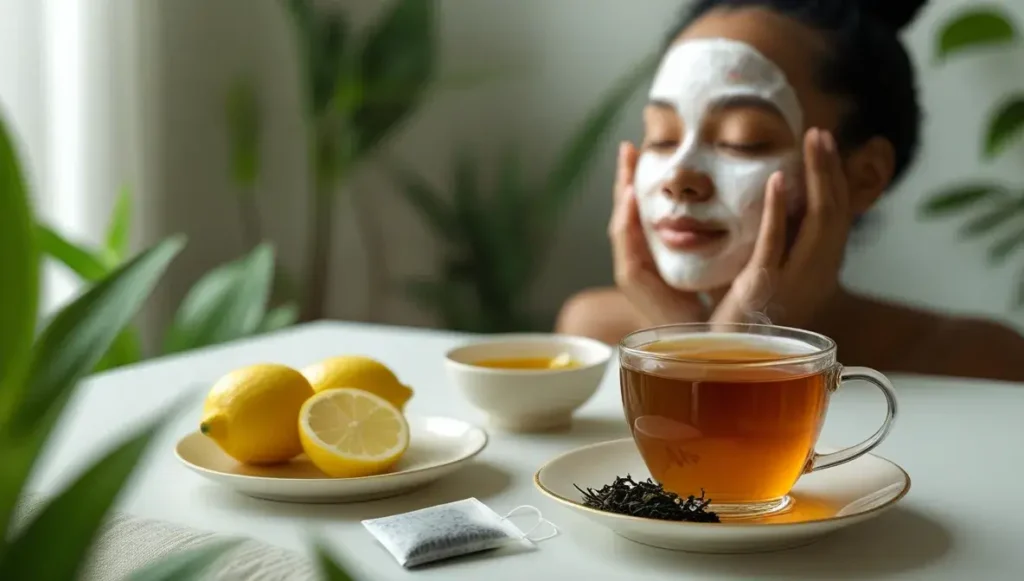
When you’re looking for natural acne remedies, certain teas really stand out. These herbal solutions for breakouts offer a gentler approach compared to some harsher treatments. Let’s explore some of the top contenders.
Green Tea’s Potent Properties
Green tea is often hailed as a powerhouse for skin health, and for good reason. It’s packed with antioxidants, like EGCG, which are known to fight inflammation and reduce the bacteria that can cause acne. Studies have even shown that topical green tea can be as effective as some conventional acne treatments in reducing oil production and improving breakouts. It’s a fantastic option if you’re dealing with oily skin and want to manage sebum naturally.
Chamomile for Inflammation and Bacteria
Chamomile isn’t just for calming nerves; it’s also a great ally for your skin. It possesses anti-inflammatory and antibacterial properties that can help soothe redness and fight acne-causing germs. Applying cooled chamomile tea or a chamomile compress can offer a gentle way to calm irritated skin.
Spearmint Tea for Hormonal Balance
For those whose acne seems linked to hormonal fluctuations, spearmint tea might be worth considering. Some research suggests it can help balance certain hormones that contribute to breakouts, particularly in women. However, it’s wise to use this one with a bit of caution and perhaps consult with a healthcare provider, especially if you have underlying health conditions or are pregnant or breastfeeding.
Rooibos Tea’s Antioxidant Power
Rooibos, or red tea, is another gem in the world of natural acne treatments. It’s loaded with antioxidants that protect your skin from damage and can help regulate your immune response, which may reduce the severity of inflammatory acne. Topically, it can help clear away excess oil and dead skin cells, contributing to clearer skin.
Exploring Other Beneficial Teas
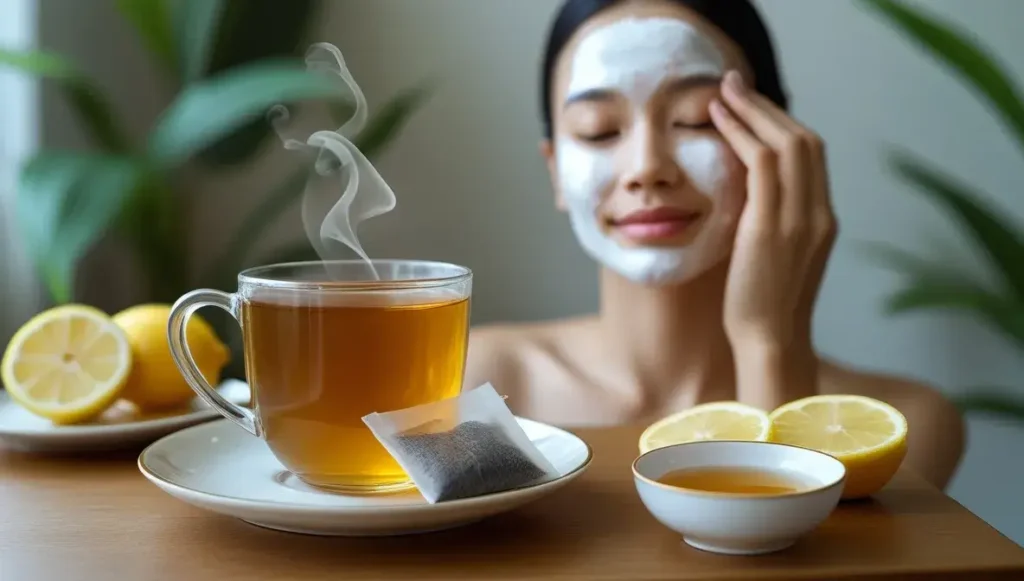
While green tea and chamomile get a lot of the spotlight for acne, other teas offer unique benefits too. It’s worth exploring these options to see if they might be a good fit for your skin.
Hibiscus Tea for Exfoliation
Hibiscus tea is packed with antioxidants, like Vitamin C and beta-carotene, which are great for overall skin health. But what’s really interesting for acne is its natural content of alpha-hydroxy acids (AHAs), specifically malic acid. AHAs are known for their exfoliating properties. They help to gently slough off dead skin cells, which can prevent pores from getting clogged in the first place. This can lead to fewer breakouts. Plus, some research suggests hibiscus might help with collagen production, which could be a bonus if you’re dealing with acne scars.
Stinging Nettle for Blood Purification
Stinging nettle might sound a bit harsh, but it’s actually a pretty useful herb. Traditionally, it’s been used to ‘purify the blood,’ which in herbal terms often means helping the body get rid of waste products more efficiently. When your body’s systems are working well, it can sometimes reflect in clearer skin. It also has anti-inflammatory properties that could help calm down angry, red pimples.
Dandelion Tea for Liver Support
Your liver plays a big role in filtering toxins from your body. If your liver isn’t working optimally, it can sometimes show up on your skin as breakouts. Dandelion tea is often recommended to support liver function. By helping your liver do its job, you might indirectly see an improvement in your complexion. It’s thought to help with bile production, which aids in digestion and toxin removal.
White Tea’s Anti-inflammatory Effects
White tea is the least processed of all the teas made from the Camellia sinensis plant. Because it’s so minimally processed, it retains a high concentration of antioxidants. These antioxidants give it strong anti-inflammatory effects. Reducing inflammation is key when it comes to calming down acne, making white tea a gentle yet effective option for soothing irritated skin.
👉 Get the Ultimate Acne Tea Blend for Radiant Glow Today 👈
Enhancing Tea’s Acne-Fighting Potential
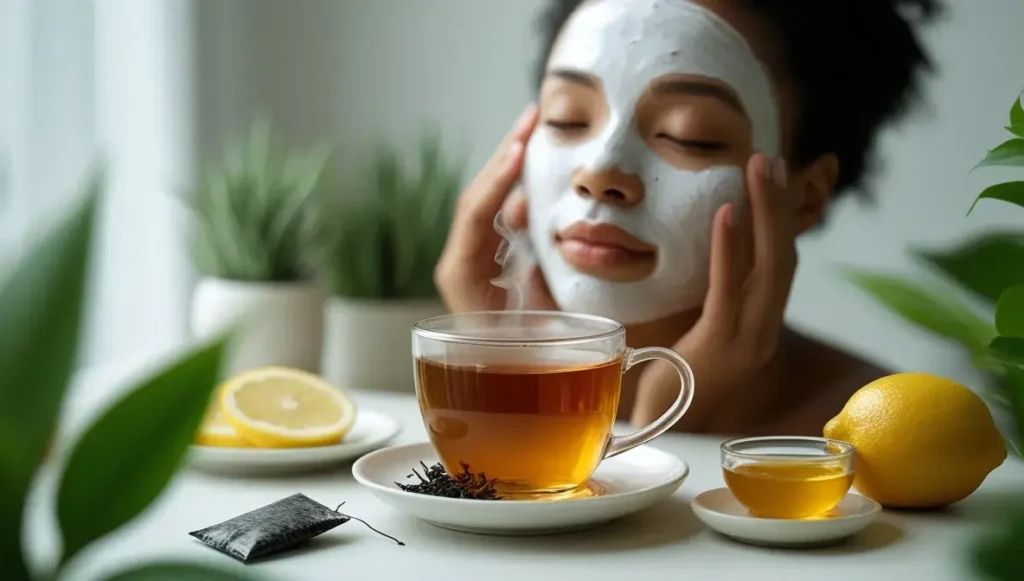
Sometimes, you want to give your tea for skin breakouts a little extra boost. It’s like adding a secret weapon to your diy acne remedies using tea arsenal. One really popular way people are reducing acne with tea is by mixing it with tea tree oil. Think about it: green tea is great for calming things down and trying to control oil, while tea tree oil is known for its germ-fighting power. Together, they might just be a super team for those stubborn tea for pimples.
Here’s a simple way to try this combo:
- Brew your favorite green tea and let it cool completely. You can even use a cooled tea bag directly from your last tea bag acne treatment session.
- Add just a couple of drops of tea tree oil to the cooled tea. Seriously, a little goes a long way with tea tree oil, so don’t go overboard.
- Dip a cotton pad into this mixture and gently dab it onto the areas where you usually get breakouts. It’s a nice way to do a little tea bag facial treatment.
Remember to always do a small patch test on your inner arm before applying anything new to your face, just to make sure your skin plays nicely with the combination.
Beyond just mixing ingredients, think about how tea fits into your whole skincare routine. You can find lotions and serums that already have green tea in them, which makes it super easy. Or, if you’re really serious about getting those benefits from the inside out, some people even take green tea supplements. It’s all about finding what works best for your skin and making it a regular thing.
Important Considerations for Tea Use
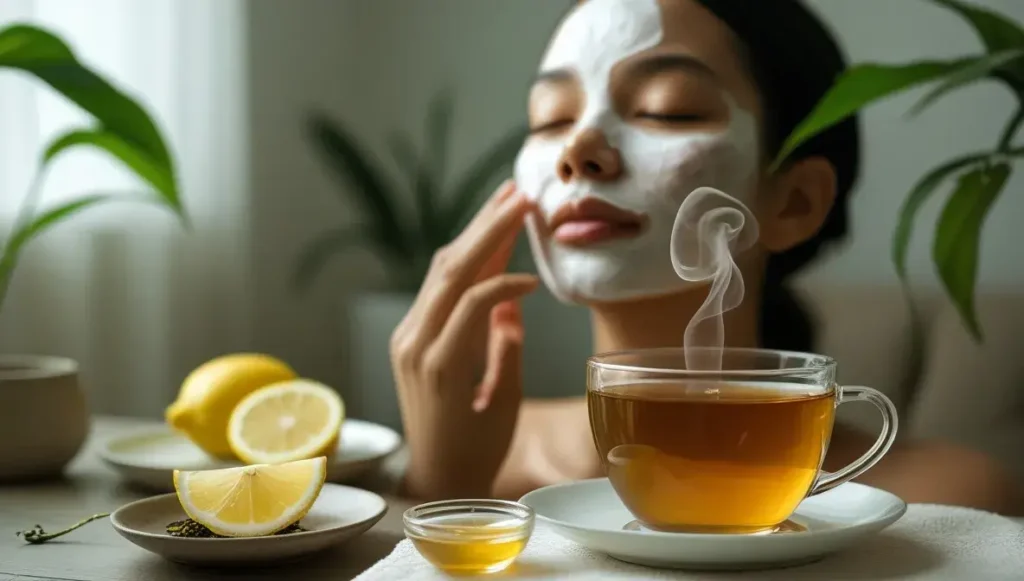
So, you’re ready to give tea a shot for your acne. That’s awesome! But before you go slathering yourself in chamomile or green tea, let’s chat about a few things to keep in mind. It’s not just about grabbing any old tea bag from the back of your cupboard.
Choosing High-Quality Teas
When you’re picking out teas for your skin, think about quality. Organic, loose-leaf teas are often a better bet than the dust you sometimes find in tea bags. Why? Well, they tend to have more of those good-for-you compounds. Look for brands that tell you where the tea comes from and how it was grown. It’s like choosing good produce – the source matters!
Potential Side Effects and Precautions
Even though tea is natural, it’s not always a perfect fit for everyone. Some people might find their skin gets a little dry, or maybe you’ll notice a slight reaction. It’s always a good idea to do a patch test first. Just apply a little bit of the cooled tea to a small area of your skin, like your inner arm, and wait 24 hours to see if anything weird happens.
Also, if you’re thinking about taking tea supplements or drinking a lot of tea for acne, it’s smart to chat with your doctor. They can help you figure out if it’s safe with any medications you’re already on. Some studies have pointed to potential liver issues with very high doses of green tea extract, so moderation is key.
Consistency is Key for Results
Don’t expect miracles overnight. Like most skincare things, you’ll probably need to stick with it for a while to see a difference.
Here’s a general idea of how often you might want to try it:
- Toner: Apply cooled tea with a cotton pad once or twice a day after cleansing.
- Poultice: Use a tea-soaked cloth on affected areas for about 15 minutes, maybe a few times a week.
- Direct Bag Application: Gently place cooled, used tea bags on blemishes for 5-10 minutes daily.
Remember, your skin is unique, so what works wonders for one person might be just okay for another. Pay attention to how your skin responds and adjust accordingly.
It’s easy to get excited about natural remedies, but it’s important to approach them with a bit of caution and common sense. Think of tea as a helpful addition to your routine, not a magic bullet. Always listen to your skin and don’t be afraid to seek professional advice if you’re unsure about anything.
👉 Experience Top Acne Tea Formula for Clear, Smooth Skin Today 👈
Conclusion: Does Tea Bags Help With Acne?
So, there you have it. Using tea bags for acne might not be some magic bullet, but it’s a pretty gentle way to give your skin a little extra help. Whether you’re sipping on some green tea or using a cooled chamomile bag as a compress, these natural methods can really make a difference for some people. Just remember to be consistent and patient with it. And hey, if you’re unsure about anything or have really stubborn breakouts, chatting with a doctor or a skin specialist is always a good idea. Keep experimenting, and hopefully, you’ll find the tea routine that works best for you.
Frequently Asked Questions
What types of tea are good for acne?
You can use green tea, chamomile, spearmint, rooibos, hibiscus, white tea, stinging nettle, or dandelion tea. Each tea has its own special benefits for your skin, like fighting bacteria or calming redness.
Does green tea really help with acne?
Yes, green tea is really good for acne! It has stuff called antioxidants, especially one called EGCG. This helps calm down redness and swelling, and it can even help control the oil your skin makes, which often causes pimples.
How can I use tea on my skin for acne?
You can make a simple toner by brewing the tea, letting it cool, and then dabbing it onto your face with a cotton ball after washing. You can also put a cooled tea bag directly on a pimple for a few minutes to calm it down, or soak a cloth in the cooled tea and put it on your face like a warm compress.
Should I use warm or cold tea on my skin?
It’s best to let the brewed tea cool down completely before putting it on your skin. Putting hot tea or a hot tea bag on your face could burn you, and that would make things worse!
Will tea completely cure my acne?
While tea can help a lot, it might not clear up severe acne all by itself. It’s a great natural helper, but if your acne is really bad, it’s a good idea to talk to a doctor or a skin specialist. They can help you figure out the best plan for your skin.
Can I mix green tea with other things, like tea tree oil?
Yes, you can mix green tea with a little bit of tea tree oil. Tea tree oil is also known for fighting acne. Just mix a few drops of tea tree oil into your cooled green tea and apply it to your skin with a cotton ball. Always test it on a small spot first to make sure your skin likes it!


![Jasmine Tea vs Green Tea Benefits: Which Gives Better Health Results? [2025] jasmine tea vs green tea benefits](https://www.goteaworld.com/wp-content/uploads/2025/09/jasmine-tea-vs-green-tea-benefits-150x150.webp)










